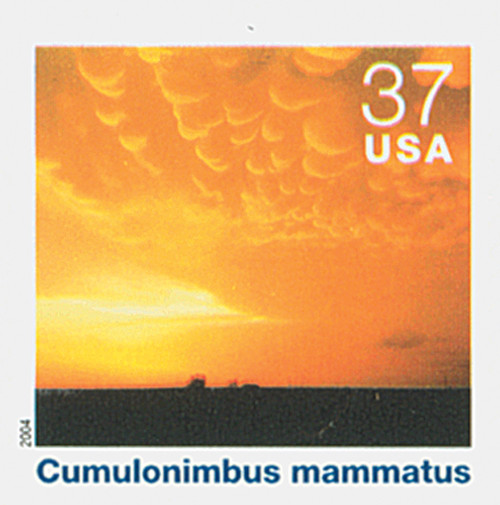
# 3878 - 2004 37c Cloudscapes
2004 37¢ Cloudscapes
City: Milton, MA
Quantity: 8,336,000
National Stamp Collecting Month

On October 1, 1981, the USPS began its very first National Stamp Collecting Month, a celebration that continues to this day.
The USPS and the Council of Philatelic Organizations created National Stamp Collecting Month in 1981. In announcing the annual celebration, then-Postmaster General William F. Bolger encouraged “employees and customers alike to discover the joy of stamp collecting – the hobby of a lifetime.”

That first year, the USPS produced a Souvenir Card picturing two stamps – US #245, the $5 Columbian, and #1918, the 1981 “Benefiting Mankind” stamp from that year’s Space Achievement issue. The theme that first year was “Discover Stamp Collecting – the Hobby of a Lifetime.”
In 1982, another souvenir card was issued, picturing US #C3a, the legendary Inverted Jenny. The 1983 card pictured US #293, the Mississippi River Bridge from the Trans-Mississippi Exposition. The theme that year was “Discover the Beauty and Lore of Stamp Collecting… the Hobby of a Lifetime.” The 1984 card pictured US #2104, the Family Unity stamp, to go with the theme “Fall in Love with Stamp Collecting – A Family Hobby.”

In 1985, the USPS issued its first stamps specifically for National Stamp Collecting Month, picturing different breeds of horses. Ever since they’ve issued a set of stamps most years in early October or late September to celebrate National Stamp Collecting Month. Often, these stamps are geared toward children, to help increase interest in a new generation of collectors.
And whether or not a new set of stamps is issued each year, the USPS and local stamp groups often stage National Stamp Collecting Month events. Many years the USPS has also created special National Stamp Collecting Month cancelations.
See below for several of the past National Stamp Collecting Month issues. We’ve pictured a few of them, but you can click on any of the links to see the stamps, read more about them, and order them for your collection.
US #2240-43 – 1986 Woodcarved Figurines
US #2362-66 – 1987 Locomotives
US #2390-93 – 1988 Carousel Animals
US #2508-11 – 1990 Sea Creatures
US #2568-77 – 1991 Space Exploration
US #2705-09 – 1992 Wild Animals
US #2785-88 – 1993 Children’s Classics
US #2863-66 – 1994 Wonders of the Sea
US #3105 – 1996 Endangered Species
US #3168-72 – 1997 Classic Movie Monsters
US #3238-42 – 1998 Space Discovery
US #3351 – 1999 Insects and Spiders
US #3439-43 – 2000 Deep Sea Creatures
US #3661-64 – 2002 American Bats
US #3814-18 – 2003 Reptiles and Amphibians
US #3945-48 – 2005 Constellations
US #4203-04 – 2007 Polar Lights
US #4352 – 2008 Great Lakes Dunes

US #4806 – 2013 Inverted Jenny– Issued September 22 to coincide with the opening of the William H. Gross Gallery at the National Postal Museum
2004 37¢ Cloudscapes
City: Milton, MA
Quantity: 8,336,000
National Stamp Collecting Month

On October 1, 1981, the USPS began its very first National Stamp Collecting Month, a celebration that continues to this day.
The USPS and the Council of Philatelic Organizations created National Stamp Collecting Month in 1981. In announcing the annual celebration, then-Postmaster General William F. Bolger encouraged “employees and customers alike to discover the joy of stamp collecting – the hobby of a lifetime.”

That first year, the USPS produced a Souvenir Card picturing two stamps – US #245, the $5 Columbian, and #1918, the 1981 “Benefiting Mankind” stamp from that year’s Space Achievement issue. The theme that first year was “Discover Stamp Collecting – the Hobby of a Lifetime.”
In 1982, another souvenir card was issued, picturing US #C3a, the legendary Inverted Jenny. The 1983 card pictured US #293, the Mississippi River Bridge from the Trans-Mississippi Exposition. The theme that year was “Discover the Beauty and Lore of Stamp Collecting… the Hobby of a Lifetime.” The 1984 card pictured US #2104, the Family Unity stamp, to go with the theme “Fall in Love with Stamp Collecting – A Family Hobby.”

In 1985, the USPS issued its first stamps specifically for National Stamp Collecting Month, picturing different breeds of horses. Ever since they’ve issued a set of stamps most years in early October or late September to celebrate National Stamp Collecting Month. Often, these stamps are geared toward children, to help increase interest in a new generation of collectors.
And whether or not a new set of stamps is issued each year, the USPS and local stamp groups often stage National Stamp Collecting Month events. Many years the USPS has also created special National Stamp Collecting Month cancelations.
See below for several of the past National Stamp Collecting Month issues. We’ve pictured a few of them, but you can click on any of the links to see the stamps, read more about them, and order them for your collection.
US #2240-43 – 1986 Woodcarved Figurines
US #2362-66 – 1987 Locomotives
US #2390-93 – 1988 Carousel Animals
US #2508-11 – 1990 Sea Creatures
US #2568-77 – 1991 Space Exploration
US #2705-09 – 1992 Wild Animals
US #2785-88 – 1993 Children’s Classics
US #2863-66 – 1994 Wonders of the Sea
US #3105 – 1996 Endangered Species
US #3168-72 – 1997 Classic Movie Monsters
US #3238-42 – 1998 Space Discovery
US #3351 – 1999 Insects and Spiders
US #3439-43 – 2000 Deep Sea Creatures
US #3661-64 – 2002 American Bats
US #3814-18 – 2003 Reptiles and Amphibians
US #3945-48 – 2005 Constellations
US #4203-04 – 2007 Polar Lights
US #4352 – 2008 Great Lakes Dunes

US #4806 – 2013 Inverted Jenny– Issued September 22 to coincide with the opening of the William H. Gross Gallery at the National Postal Museum




















